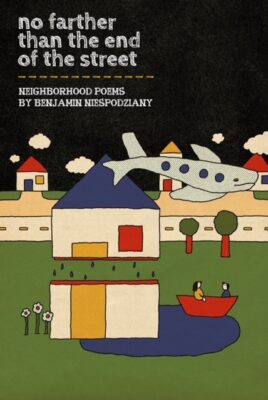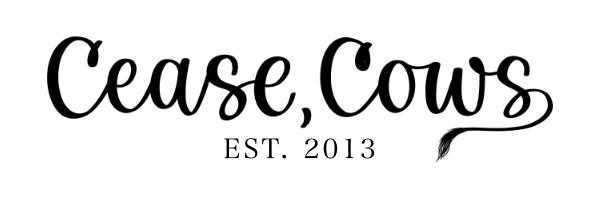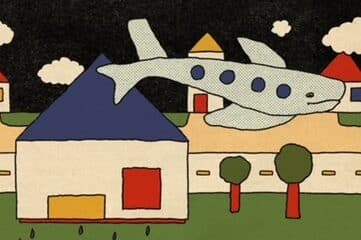Is it poetry? Is it flash? When it comes to the work of Benjamin Niespodziany, it doesn’t matter. Whatever the label, the author’s work will transport you to an imaginative realm where you’ll never know what to expect. Sometimes comic, often surreal, Niespodziany’s work will linger in your mind and deliver an emotional wallop. His book No Farther Than the End of the Street arrives in November.
Purchase your copy here.

Niespodziany shared his thoughts in a recent interview with Cease, Cows.
Chuck Augello: No Farther Than the End of the Street is a unique book. How do you describe it to potential readers?
Benjamin Niespodziany: For fellow writers and/or those who know the literary world, I might describe it as a collection of absurdist prose poems with one common constraint: each poem takes place on a single street.
For someone like my parents, who read Tom Clancy and Delia Owens, I might describe it as a book of stories inspired by Pleasantville and The Truman Show and love and newfound domesticity upon moving in with my partner.
CA: Were the individual pieces written with the structure of the book in mind, or did the structure take shape later? Tell us about the challenges in creating a book like this one.
BN: I think a little bit of both, but the structure mainly took shape at a later date. During the pandemic, I was really able to sit down and look at all of my poems and notes and early scraps and shitty first drafts and crystalline gems I’d misplaced in the sludge. While this was happening, I noticed a bunch of these poems took place inside a home/house/apartment, and many of them took place looking out the window, or imagining something down the street, or seeing a neighbor doing something strange. All of these poems were written at different times, but when I clumped them all together, they started talking to each other, and I was able to kind of collage/mosaic a somewhat (hopefully) noticeable story arc and through-line. That being said, I still wanted each piece to work on its own as a standalone tale or side story.
CA: Some of these pieces are poems. Others might be considered microfiction. What do you see as the difference? Do you intentionally set out to write one or the other? Should readers bring different expectations based on the form?
BN: I think my writing can go in many directions. I’ve submitted a paragraph to a fiction journal and that same paragraph to a poetry journal. Regardless of classification, my writing is always sparse and rarely with a resolution or proper ending.
I often write my first drafts as one long freeform stanza. Then I edit it down into couplets or tercets. Then, almost always, I get frustrated by verse and intimidated by verse, so I turn it into a paragraph and trim some more. Most of my writing ends up as a paragraph under 100 words, so whether that’s a prose poem or microfiction or flash fiction or a vignette or a postcard love note, I have no idea.
CA: One of my favorites is “Publicity Stunt.” Tell us about it.
BN: Thank you! I’m glad you enjoyed that one. That’s one of the earlier poems in the book and it was written during a Skype workshop (before we knew about Zoom) with Zachary Schomburg in 2018 or 2019. I brought a draft of this poem to a class and we worked the hell out of it, expanding it and reworking it until it was about double the length. It was published at The Operating System in 2019, initially titled “Planet Earth is a Publicity Stunt,” and has since seen many edits. As far as actual concept, I really liked the idea of someone passing around a painting or a sculpture (or, in this case, an X-Ray) during a reading and having that be the poem.
CA: Your piece “Ice Sculpture” was published by Cease, Cows. How did you come to write it?
BN: I email all of my first drafts to myself, so I can check: it was written in February of 2018. Wow. How time hurries. I don’t remember what brought me to the blank page with that one, but I’ve always been impressed and fascinated by someone chainsawing a block of ice into an angel or Santa Claus or whatever. Bill Murray does it in Groundhog’s Day (it’s possible I had recently watched it) and Crispin Glover does it in Hot Tub Time Machine, so I think that art form is implanted in my head. I obviously took the concept a step further until we arrived at “Ice Sculpture.” It’s since seen a few revisions, is now known as “Ice Sculptor,” and is in a manuscript of family-focused poems currently out on submission.
CA: A section of the book is titled “Front Lawn Songs.” An intriguing title. What should readers expect?
BN: Yes! So, when this book was still an early manuscript, it was originally titled The Flimsy Chimney, and when I realized I wanted all of the chosen poems to take place on a single street, the chimney felt like a small part of a bigger picture. So rather than be the title, it became a section of the book, and every other section followed suit and expanded this idea to be a segment of this micro world.
As a result, we have Yardmouth (another contender for an early book title), Baffling Scaffolding, The Flimsy Chimney, Front Lawn Songs, and Partial Architectures. Obviously, these are conceptualized as “neighborhood poems” so you can think of a sitcom (or the two movies I include as epigraphs), but I wanted each section to contain an element of uncertainty or surprise or mischief or untrustworthiness. There’s a house, but the chimney might topple, and the scaffolding makes no sense, and someone’s singing in the yard, and that shed is only partly done, etc. Every title in the book is meant to enhance this tiny world-building bubble.
CA: The images and connections in your work are often surreal and show great imagination. Are there things you do to keep your imagination primed?
BN: I watch a lot of movies. I listen to a lot of music. I’m often bored by reality. If my routine becomes too disciplined or familiar, I start to feel like I’m watching a re-run of my own life. That feeling often leads to me changing things up in my actual life (new restaurant, new book, solidifying a future getaway) but also leads to me changing things up in my writing (giving a neighbor gigantic hands, seeing what happens when a firetruck catches on fire, admiring a botanic garden before noticing many guests testing their limits by jumping into quicksand). My writing might be inspired by reality, but rarely do I write something realistic. I like to be surprised when I write, and if I’m telling a story I already know, I’d rather watch a show. Like The Patriot or Atlanta or Perpetual Grace, LTD.
CA: In a recent essay in The New York Review of Books about Ukrainian writer Serhiy Zhadan, Sophie Pinkham refers to the tradition of the poet as “rebellious celebrity and national hero.” Zhadan reads his poetry to sold-out audiences of adoring fans. But this tradition, as Markham notes, has been all but extinguished in the West, particularly in the United States. What are your thoughts on this and do you see any ways that poets can reach a larger audience in the current culture?
BN: “Rebellious celebrity” is really interesting here. I forget where I heard/read this, but there was an Eastern European author saying how their parents were honored and thrilled to have their child aspire to become a poet. It’s seen so much differently over there than it is here. Literature is revered. Here, it’s seen as cryptic and confusing and not nearly as cherished.
I think understanding the digital possibilities is a great way to align the world with literature. In October, I’m curating a reading with a British surrealist and two Canadian novelists and it’s great to have those possibilities. None of us have to fly to each and we get to celebrate writing together. I’ve attended poetry readings (virtual) where 100+ people are listening and other times, I’ve gone to in-person readings and only 4 people were in the crowd. It’s tricky, and I certainly don’t think poets have nearly as much celebrity in the States as elsewhere, but there are some poets who are “rebellious celebrities” in America who can pack a room. Mary Ruefle, Victoria Chang, Kaveh Akbar, Hanif Abdurraqib, Jose Olivarez. Celebs in my book.
CA: Who are some of the writers you admire? Are there any writers that you’d like to recommend to our readers?
BN: Where do I even begin? I’ve been writing micro-reviews of recent reads over on my blog. That might be the best place to start.
Since the focus has been on my debut poetry collection, I’ll recommend the four who provided blurbs. Without them, my book would be quieter and less majestic.
Zachary Schomburg. An inspiration and a mentor and a friend. He helped me with many early edits and workshops when I was first writing poetry, and his work has been nearby ever since. While his poetry collections are amongst my favorite in my collection, his novel Mammother might be my favorite novel. Ever.
CAConrad. They just won a Ruth Lilly Poetry Prize! The Book of Frank was a huge inspiration for my book, with much of the absurdist grotesque surrealism swirling in my brain and realizing I can do whatever I want on the page. I adore CA’s newest collection, Amanda Paradise. Enchanting.
Dalton Day is a joy! He’s always providing prose poems and illustrations on his social pages and every day is something new and inspiring. Prolific is an understatement. His book Exit, Pursued cracked open my head when I was first learning about prose poetry and what I can do on the page in regards to microfiction and flash fiction and poetry in general.
And last but definitely not least, Daniel Handler aka Lemony Snicket. I’ve been obsessed with A Series of Unfortunate Events for over a decade. I interviewed Handler back in 2015 right after he released We Are Pirates. Seven years after the interview and I’m still reading his work: Poison for Breakfast had me laughing like a kid again. I still can’t believe it. I’m baffled he read and replied to my blurb request.
CA: There’s no shortage of ways to pass one’s time besides writing. Why do you do it?
BN: It allows me to imagine. Escape. Surprise myself. Step away from reality for ten minutes or two hours. There’s something about the blank page that makes me giddy. I love free writing and first drafts, but I also love printing and going through my edits with a pen, then transferring them back into a Word doc and going through another edit. The whole process excites me and keeps me going and it all feels therapeutic. It’s rare that I’ll end a writing session feeling worse than before I started. I read more than I write, and I’m always eager to find some time for both.
–
Chuck Augello (Contributing Editor) is the author of The Revolving Heart, a Best Books of 2020 selection by Kirkus Reviews. His work has appeared in One Story, SmokeLong Quarterly, Literary Hub, The Coachella Review, and other fine journals. He publishes The Daily Vonnegut, a website exploring the life and art of Kurt Vonnegut. His novel, A Better Heart, was released in November 2021.
Benjamin Niespodziany‘s work has appeared in Cheap Pop, Fence, Fairy Tale Review, Gone Lawn, Hobart, Wigleaf, and various others. Along with being featured in the Wigleaf Top 50, his writing has been nominated for the Pushcart Prize, Best of the Net, and Best Microfiction. His debut chapbook The Northerners was released in 2021 by above/ground press and his second chapbook Pickpocket the Big Top was released in May 2022 by Dark Hour Books. No Further Than the End of the Street is his debut, full-length collection. You can find out more at neonpajamas.com.

